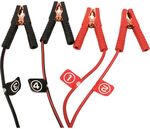Same leads SCA are selling for $106.99
https://www.supercheapauto.com.au/p/sca-sca-12v-750-amp-jump…
PRODUCT INFO
For a quick fix in a tricky spot, a set of SCA Jumper Leads (or Jumper Cables) are a great companion on your next journey. These car jump leads are perfect for a flat battery when you need to get on the go, and don't have hours to spend attached to a charger. The fully insulated clips and high quality copper and aluminium construction will keep your hands safe from current while connecting cables, and the in-built surge protection will help prevent any damage to the battery on either end during the process. With a handy plastic storage case to prevent any tangling or damage, you can trust they will always be ready when you need them.
These SCA 12V 750 Amp Jumper Leads are numbered near each clip to ensure that you have no issues correcting in the right order. They are suitable for starting petrol engines up to 6.0L (6000cc) and diesel engines up to 5.0L (5000cc), making them a great solution for large-engine vehicles and 4WD's that require a lot of power to turn over.
FEATURES
Suitable for 4, 6 and 8 cylinder petrol engines up to 6L (6000cc), and diesel engines up to 5L (5000cc)
Built-in surge guard protects vehicle electronics and engine management systems
Insulated copper/aluminium cables for quality and durability
3.5m long to make sure you've got the reach when you need it
Handy plastic carry case for neat and tidy storage at home or in the boot





No c&c near me